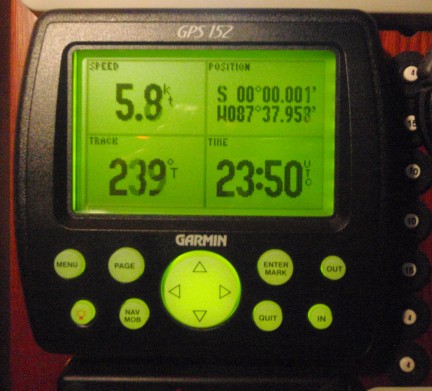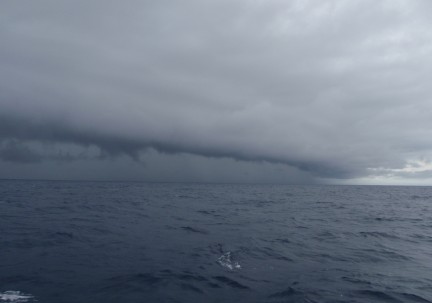PANAMA TO THE GALAPAGOS ISLANDS
We had not had any internet access since leaving Shelter Bay Marina eight days earlier, so we had limited weather information. However, we did see that the undulating ITCZ was sitting pretty much right on top of us, so we expected a light air downwind sail. We put up our genoa while in Las Perlas Islands. But this passage was not at all what we expected.
We left early on the morning of May 23. We had very little wind and flat seas. We enjoyed the pelicans, dolphins, jumping fish, and a turtle. We got a little light rain that gave the boat a much needed rinse. We saw a few fishing boats close in and many ships funneling toward the Gulf of Panama and the canal. We did some sailing and some motorsailing. We had lots of lightening and winds from all directions during the night keeping us both busy during our watches.

Lousy Weather
Our second day dawned with the ITCZ slipping slightly south, and we were just on its southern edge. We needed to get south to find the trade winds. Our wind dropped to 5 knots, so we motorsailed. The skies improved with a few patches of blue and no thunder. We had less lightening during the night, and we hoped for better weather ahead.
Our third day brought head winds, squalls, and rough seas. Our bouncing around stirred up some sediment somewhere in our fuel system, and we had a blocked fuel filter. We hove to to repair it.
We realized that the seas were too rough for us to tie to the mooring at Isla Malpelo, so we decided to carry on to the Galapagos. The wind was on our SW rhumbline, so we had to go either south or west. When heading south, the current was forcing us southeast – toward mainland Ecuador. When heading west, the current was forcing us northwest – toward Mexico. We tacked a few times and sailed with a single reef in the main and the staysail. We pinched at 30 to 35 degrees apparent wind angle all night in rough seas. At least there was less lightening. But Bud was feeling bad and possibly getting sick.
The winds backed slightly on our fourth day, and we were able to steer below 270 degrees. The seas calmed enough that we decided to unfurl our genoa, and we discovered it had two tears in it. While taking it down, a tear snagged on the upper spreader, and it tore all the way across. We got the yankee up while a moderate rain fell. The wind and seas increased again, and we made slow progress with current against us. Bud was sick with another cold.
Our fifth day started as another of rough seas, so we continued on motorsailing close hauled with a reefed main and staysail. We were still having fuel problems, but we were able to hold a better course, and the current was only slightly against us. During the day, the seas calmed, and we were able to sail with our full main and yankee. That night was our first without lightening.
Our sixth day brought clearing skies and current with us – finally! We continued still close hauled, and we were very tired of the boat motion and heel. The air temperature had cooled considerably, and we got out fleece blankets at night.

Crossing the Equator again
On day seven, our winds backed a bit to SSE. The seas were still bumpy, and we were very tired of the motion, but we were able to crack off to 50 to 60 degrees apparent wind angle – a substantial improvement after four days at 30 to 35 degrees. We crossed the equator at 87.38W – about 110 miles east of the Galapagos.
On day eight, our winds increased to 24 knots in the early morning, and the seas remained bumpy. But we pressed on, and we arrived Puerto Villamil on Isla Isabella at 1600 GMT or local noon. We were glad this one was done.
In many ways, this was just another not-so-great passage. But we had two interesting experiences that we will likely remember. One involved fish, and the other two fishermen.

More Lousy Weather
We did not do much fishing because of the lousy conditions, but we did throw in a line twice. We caught a few fish, but none made it to our table.
On day two, we were optimistic with clearing skies, so we put out a lure. Something very big hit it. It snapped our heavy line, and Nita looked back just in time to see the splash. She did not see the fish, but she saw a splash bigger than any fish we have ever caught. She knew that this was bigger than anything that we could land on our deck, and she was glad it got away.
On day three, before conditions deteriorated, Bud put out two lures. He caught a small tuna on one, but it is a fish we do not like. It was still in decent condition when he got it to the boat, so he unhooked it and released it. Almost immediately another fish hit the lure on the other side, and Bud was bringing it in when a bigger fish came along and took it. The food chain in action.
So we did catch three or four fish, but none made it to the table. Fish slayer’s reputation is in jeopardy.
On day five, we had an encounter with a fishing boat that has troubled us since. It reminded us how much we have changed during our years of cruising.
We saw a small open boat ahead of us with two persons on board. We were at approximately 01.50N and 083.13W. That is 200 miles from mainland Ecuador and 400 miles from the Galapagos. And this open boat had only one outboard engine.
The boat crossed our bow causing us to slow down. We were going very slow when they crossed our bow again forcing us to stop. They came alongside and indicated they would like some cigarettes. We told them we did not have any, and we sailed on.
In years past, we would have enjoyed this encounter. What are they doing so far out here? Where did they come from? What would they do with their catch? Did they need anything? Food? Water? But we did not want to spend time with them. We wanted to continue on.

Approaching Isla Isabella under blue skies
This is sad. Crimes against cruisers have jaded us to the point that we are intimidated by experiences that previously would have been pleasurable. We still think about this and how it reflects changes in how we see the world around us.
But we made it in eight days and four hours. We spent six of those days sailing to weather in bumpy seas and four of those six close hauled at 30 to 35 degrees apparent wind angle. We had current against us for five days, and Bud was sick for four days. We sailed 1064 miles for an average of 5.4 knots per hour. That is a bit slower than we like, but it is not bad considering the conditions.
Come along with us to the Galapagos Islands,